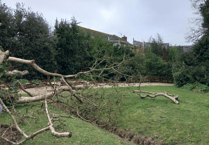WORK needs to start as rapidly as possible on increasing the capacity of Wimbleball Lake, on Exmoor, if chronic water shortages are to be avoided, West Somerset MP Ian Liddell-Grainger is warning.
Mr Liddell-Grainger said it was vital more water was penned in Wimbleball, one of the largest reservoirs in the Westcountry, as the effects of climate change became ever more alarming.
The reservoir was built in response to the 1976 drought year, but after a hot and dry 2022 summer it was this week only at 17 per cent capacity - a level not seen since its original impounding.
And despite owner South West Water (SWW) pinning hopes on heavy winter rains to refill it, there were fears households across a wide swathe of Somerset and Devon could face rationing next year if the downpours failed to arrive.
Mr Liddell-Grainger has already accused SWW of recklessness in not imposing restrictions on water use early enough during this year’s record-breaking summer.
Now, he wants the company to implement contingency plans and add 10 feet to the height of Wimbleball’s 160-foot dam wall.
Mr Liddell-Grainger said: “The original design of the Wimbleball dam allowed for this to happen at some future point and in my opinion that point has now been reached.
“Wimbleball was the last major storage facility to be built in the South West and it is clear that in its present form it is inadequate to meet the increased demands from thousands of new homes, particularly during prolonged hot, dry weather.”
Mr Liddell-Grainger said when Wimbleball was constructed the concept of global warming was hardly on the agenda.
He said: “In fact, scientific opinion at the time suggested we were far more likely to be heading for another ice age.
“That scenario changed when scientists began to go public on the warming challenges in the 80s and 90s.
“The worrying aspect is that not only are the changes they forecast underway, they are happening far more rapidly than all but the most pessimistic of them predicted.
“It is clear that summers of the kind we have had are likely to become the norm from now on and if the same applies to the dry springs we have also been experiencing then we are going to need to capture every last drop of rain that falls.”
Mr Liddell-Grainger said a scheme to raise the height of the dam wall could be achieved relatively quickly and inexpensively.
“But it will only buy us some time,” he said.
“In the long-term we are going to need to vastly increase water storage in this region and every other and the water companies are going to have to start immediately investing in major reservoir-building - as it was intended they would when water privatisation took place.”
South West Water said it was taking a number of measures to increase water resilience and storage across the region and there were a number of ways to do so, not just by upgrading Wimbleball’s infrastructure.
A spokesman said: “Reservoir levels at Wimbleball remain very low currently, due to the unprecedented drought and dry weather this year.
“We are planning and investing for the future today, investing in new reservoirs and finding innovative ways to collect, store, and treat water.”




